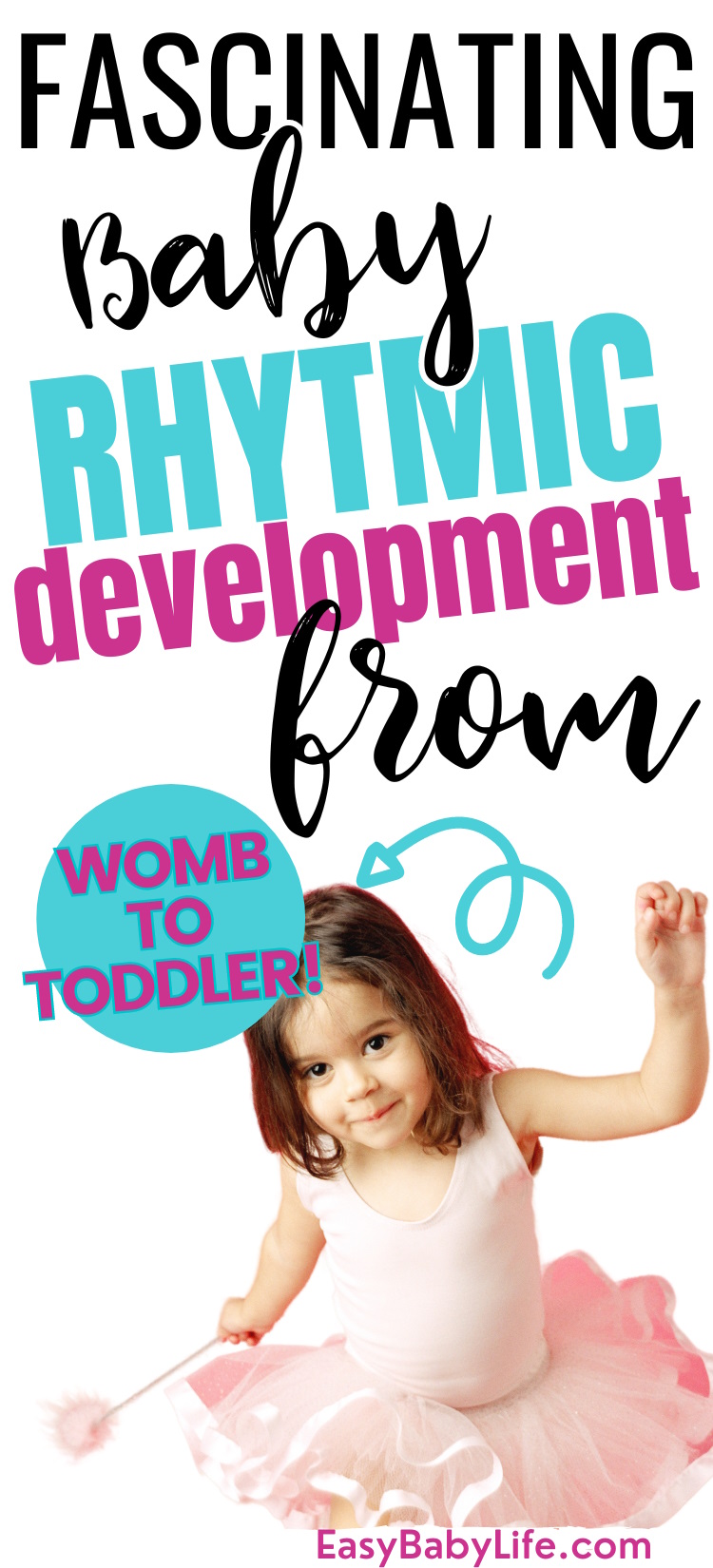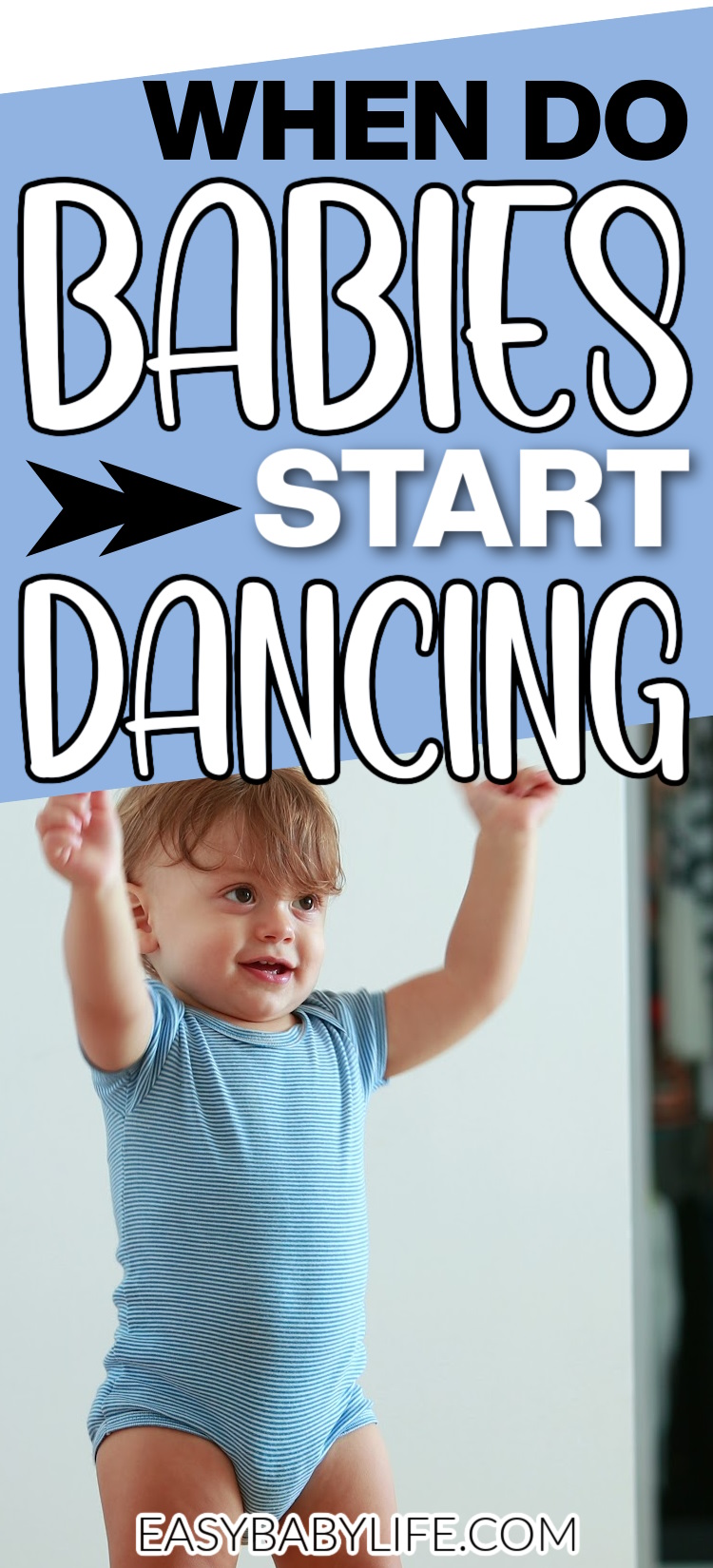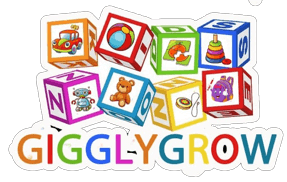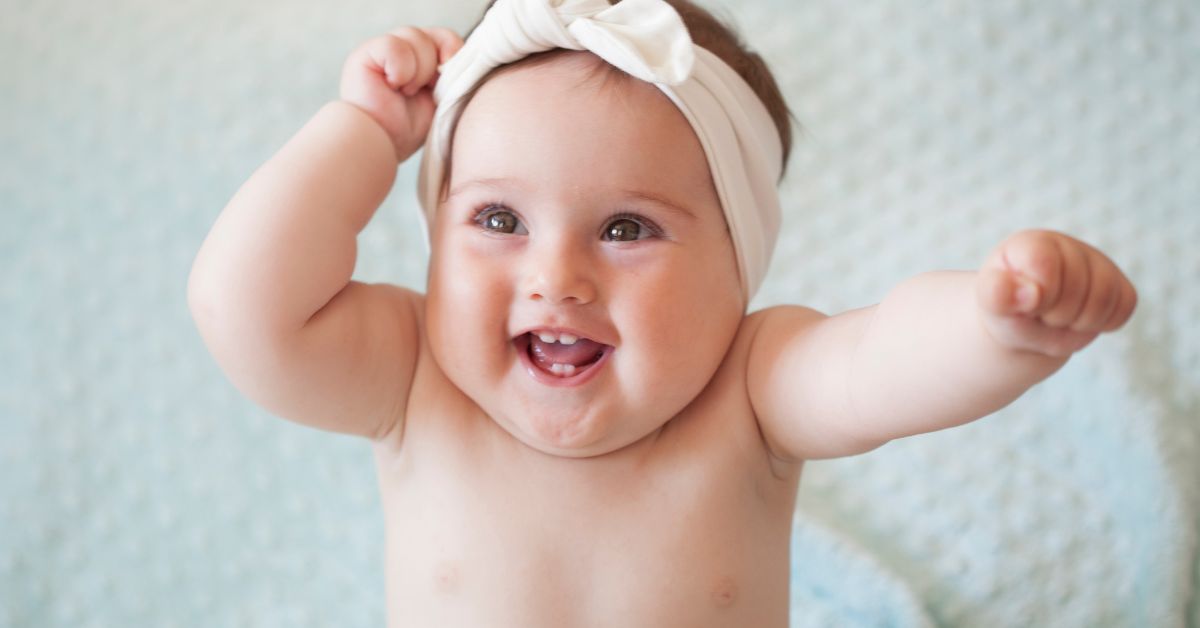We’ve all seen the viral videos of youngsters in diapers getting down to the beat. We think, “That’s incredible! How does that baby have such a good rhythm? Could this be real?”
The truth is that babies as young as 0-6 months may start dancing. My youngest son did. He “danced” to the beat of me grating carrots while in his high chair. Hillarious!
Studies have shown that babies respond to music even more positively than speech, giving way to the questions we look into in this article: “When do babies develop a sense of rhythm?” and “When do babies start to dance?”
Let’s break it down and take a look at what we know about babies’ development of rhythm and dance and why dance is an important part of a baby’s development. (The research references are listed below the article.)

When Do Babies Develop a Sense of Rhythm?
It’s a big question: When do babies develop a sense of rhythm? And the response is a bit more complicated than just saying: “At X months old”. So here, let’s break it down with the science that has sought to figure out how and when babies respond to music.
In the Womb
Just in the same way that babies can hear and recognize voices in the womb, they can hear and experience music. Specifically beginning in the second trimester babies develop hearing. One study showed that at 16 weeks gestation, babies responded to music by opening their mouths and sticking out their tongues.
Other studies prove that babies who listen to music before birth demonstrate positive bodily responses when they hear the music after birth. This suggests that newborns benefit from listening to music before and after they are born.
Premature Babies
For babies born prematurely, it has been shown that listening to music benefits their development. A group of babies in NICU born at or after 32 weeks, experienced improved vital signs, feeding, and sleeping when exposed to music. Specifically, these babies demonstrated great improvement when parents sang lullabies to them.
5–24 Month Olds
A study of children between the ages of 5 and 24 months has shown that children may be born with the innate ability to respond to rhythm. In particular, babies respond more to music than to speech.
Parents in a survey noted that they noticed their baby dancing before they could even crawl. Some as young as 5 months old have been known to get down to the beat.
At 8 months old, babies will change their dance movements between fast and slow to match the tempo of songs. They can also tell if someone is dancing off-beat.
Taking it even further, babies become even happier when they can move to the beat. They literally smile more when moving with the beat.
When Do Babies Start to Dance?
0–12 Months
Most parents notice their child begins to bop along to the music when they start to stand, which happens around the 12-month mark. But the truth is that some little ones begin to show signs of dancing as early as 5 months old. In a study across 15 countries, half of parents surveyed said their child began to dance at 6 months old.
Although children as young as 8 months old can tell if someone is dancing on or off beat, they don’t have the ability and precision to dance to the rhythm themselves. This normally doesn’t happen until preschool age.
12–24 Months
Around the time that little ones can start to stand on their own, the dancing really gets going. Studies have shown that 90% of babies demonstrate movements recognized as dancing by the time they are 12.8 months old.
What is super interesting is that these babies didn’t just do it once in a blue moon. Instead, these little ones often danced at least once a day, developing their moves over time. Specifically, by the time they were 18 months old, 80% mimicked movements they saw and incorporated them into their dance.
So, what can we understand from this? Most babies can start dancing by the time they are a year old. And if they do it often with grown-ups showing them how, they will develop their dancing as they grow.
Approaching their second birthday is when little ones will begin to master jumping with both feet and balancing on one leg. So get ready, as the dance moves really begin to take off at this stage.
3 Years and Up
When your little one is about 3 years old, they’re starting to understand play, movement, and social cues. This is the perfect point to join more formalized classes. If your child is showing interest, give it a try. But if it doesn’t seem to be their thing, don’t worry! Keep the dancing going at home.
You’ll see that at this stage, your little one will begin to develop their own dance style. It could also be a great time to show them how to do a few dance moves of your own.
Why is Dancing Important?
Brain Development
Could it be possible that music and dance help the development of your baby’s brain? Yes! Amazingly, studies have shown just that. In one study, babies as young as 9 months old showed an increase in the ability to process both music and speech.
Another study concluded that children exposed to music and music instruction show enhanced brain development compared to those who not exposed.
Dancing fosters brain development in so many ways: Watching and mimicking the movements of others exercises memory. Spatial awareness is discovered by moving the body. The physical movement of dance stimulates the vestibular receptors and system in the inner ear. This allows the baby to understand where they are in space which is at the foundation of learning.
Bonding
Dancing is a great way to bond with your little one. Studies have shown that activities involving music and dance actually create a stronger bond between infants and caregivers.
Specifically, when new moms engage in activities involving music and dance with their infants (2-6 months old), the interactions between the two significantly increase. So, if you dance around with your little one, even as early as 2 months old, your bond will only get stronger.
Happiness
This may be a given, but dancing makes people happy. As adults, we know the benefits of dance – it gets our endorphins going and our blood pumping, and, most importantly, it puts a smile on our faces.
So, it’s no wonder that the same thing happens for our little ones. A baby’s success in coordinating movements with the beat has been shown to make babies happier and smile more.
Socialization
Dancing is a social activity. Yes, you could dance in your room alone, but much of the time dancing is something to be shared with others. This has a huge impact on a baby’s social development.
As we dance together, little ones engage with others by watching them, copying them, and being happy together. But even after the dance is over, positive social behaviors continue.
A 2017 study showed that children who created music together were more likely to help each other and cooperate without being prompted to do so. So, even if you’re not singing the “Clean Up Song”, little ones will join each other to help tidy up the room.
More Benefits
Dancing benefits a baby’s development in so many more ways, including:
- Hand-eye coordination
- Spacial awareness
- Balance
- Gross and fine motor skills
- Audio and visual stimulation
- Creativity and self-expression
How to Stimulate a Baby’s Dancing?
In the Womb
While in the comfort of your belly, your baby was constantly hearing the rhythm of your pulse. By experiencing a perfect beat throughout the pregnancy, it’s no wonder that babies really respond positively to the beat and rhythm of music.
So, what does this mean for you and your little bundle of joy? The idea is that if you regularly play a song before your baby is born, they can recognize it after birth. This could be a great way to soothe your newborn.
So, consider using a specific playlist when you’re resting in the last few months of pregnancy. You may be able to use it to help your newborn settle down after birth.
Dancing With the Little Littles
Just because a little one can’t sit up on their own doesn’t mean they should be left out of the fun! For babies 0-4 months old make sure they are fully supported. Lay them on a secure surface or bouncer while dancing around them or moving their limbs to the beat for them.
It’s always fun to make them your dance partner. Whether in a secure baby carrier or in your arms, always make sure that your baby’s head is fully supported. Get down to the beat, but just don’t move too quickly.
Remember, they’re used to the rhythm of your heartbeat, so swaying, bopping, or rocking to a similar tempo is best.
Model the Dance Moves
All eyes on you! The best way to get your little one to dance is to get into the groove yourself. Show your little one how much you enjoy the music and move to the beat.
Put on the music and let yourself bop around while doing daily tasks like feeding, cleaning, and changing a diaper. This is a great way to show the value of music.
When the mood is right, then turn it into a full-on impromptu family dance party! Getting everyone involved, including older siblings and caregivers, is not only fun, it’s one of the best ways to stimulate your baby to dance.
Dance & Music Classes
Dance classes for youngsters are typically offered for little ones beginning at 2–3 years of age. This is a great way to promote balance, coordination, flexibility, and social skills. It’s also a great way to prepare for preschool by following instructions and movements.
Many classes at this age involve parent participation, which creates a secure environment for your baby while modeling classroom-ready behaviors.
Other music classes are offered for babies and their caregivers geared for children 0–2 years old. Many have classes specifically designed for children from 0–8 months old. So you can bring your baby, who’s only a few weeks old. These classes are a great way to expose little ones to the wonder of music. I took one of my sons to a music class when he was just a baby. Lots of fun, and you’ll find my tips for success in the above linked article.
Get into singing and learning songs that you can continue to sing at home. As they grow, little ones will also love to pick up instruments and see how they produce sound and get into dancing to the music.
Dance vs Talk
We all know the importance of talking with your little one even before they are verbal. However, studies have actually shown that babies respond more positively to music than they do to conversational speech. So, what’s the best thing to do? Incorporate both music and talk as ways to engage with your baby.
Takeaway
So, what is the conclusion of this dive into the science of baby dancing and rhythm development? If the takeaway can be boiled down to one word, it is this one:
Dance!
Dance with your baby, your toddler, and your older child. Expose them to music, rhythms, and dancing as soon as possible, and have fun together! Babies and even preemies and unborn babies (!) react positively to music; it enhances their brain development and puts a smile on their faces. There are really no drawbacks to adding music to your child’s life!
Read Next
Research references
-
- Movalled, K., Sani, A., Nikniaz, L. et al. The impact of sound stimulations during pregnancy on fetal learning: a systematic review. BMC Pediatr 23, 183 (2023). https://doi.org/10.1186/s12887-023-03990-7
- Kim, M., & Schachner, A. (2023). The origins of dance: Characterizing the development of infants’ earliest dance behavior. Developmental Psychology, 59(4), 691–706. https://doi.org/10.1037/dev0001436
- Loewy J, Stewart K, Dassler AM, Telsey A, Homel P. The effects of music therapy on vital signs, feeding, and sleep in premature infants. Pediatrics. 2013 May;131(5):902-18. doi: 10.1542/peds.2012-1367. Epub 2013 Apr 15. PMID: 23589814.
- Marcel Zentner, Tuomas Eerola Rhythmic engagement with music in infancy, Proceedings of the National Association of Sciences of the United States of America, March 15, 2010 107 (13) 5768-5773 https://doi.org/10.1073/pnas.1000121107
- Zhao, T. C., & Kuhl, P. K. (2016). Musical intervention enhances infants’ neural processing of temporal structure in music and speech. PNAS, 113(19), 5212–5217.
- Assal Habibi, B. Rael Cahn, Antonio Damasio, Hanna Damasio, Neural correlates of accelerated auditory processing in children engaged in music training, Developmental Cognitive Neuroscience, Volume 21, 2016, Pages 1-14, ISSN 1878-9293, https://doi.org/10.1016/j.dcn.2016.04.003.
- Vlismas, Wendy & Malloch, Stephen & Burnham, Denis. (2013). The effects of music and movement on mother–infant interactions. Early Child Development and Care. 183. 10.1080/03004430.2012.746968.
- Kirschner, S., & Tomasello, M. (2010). Joint music making promotes prosocial behavior in 4-year-old children. Evolution and Human Behavior, 31(5), 354–364. https://doi.org/10.1016/j.evolhumbehav.2010.04.004

Paula Dennholt founded Easy Baby Life in 2006 and has been a passionate parenting and pregnancy writer since then. Her parenting approach and writing are based on studies in cognitive-behavioral models and therapy for children and her experience as a mother and stepmother. Life as a parent has convinced her of how crucial it is to put relationships before rules. She strongly believes in positive parenting and a science-based approach.
Paula cooperates with a team of pediatricians who assist in reviewing and writing articles.


